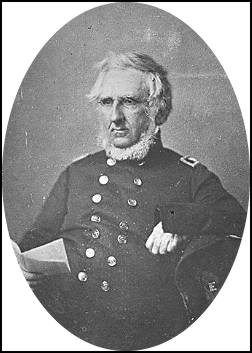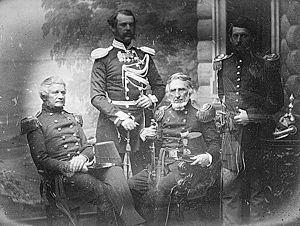Richard Delafield facts for kids
Quick facts for kids
Richard Delafield
|
|
|---|---|

Richard Delafield by Mathew Brady
|
|
| Personal details | |
| Born | September 1, 1798 New York City, New York |
| Died | November 5, 1873 (aged 75) Washington, D.C. |
| Resting place | Green-Wood Cemetery Brooklyn, New York |
| Spouse | Harriet Baldwin |
| Relations | Edward Delafield (brother) Rufus King Delafield (brother) Joseph Delafield (brother) |
| Children | 6 |
| Signature | |
| Military service | |
| Allegiance | United States of America Union |
| Branch/service | United States Army Union Army |
| Years of service | 1818–1866 |
| Rank | |
| Commands | Superintendent of the United States Military Academy United States Army Corps of Engineers |
| Battles/wars | American Civil War |
Richard Delafield (born September 1, 1798 – died November 5, 1873) was a very important officer in the United States Army. He served for 52 years, which is a long time! He was also the superintendent, or head, of the United States Military Academy at West Point, a famous military school, for 12 years.
When the American Civil War began, Delafield was a Colonel. He helped get soldiers and supplies ready for the Union Army from New York. He also led the defenses around New York Harbor from 1861 to 1864. In 1864, he became a Brigadier General and the Chief of Engineers for the Army. Later, he was given the honorary rank of brevet Major General. He retired from the Army in 1866. After retiring, he continued to serve the country by working on projects to improve harbors and lighthouses. He was also a leader at the Smithsonian Institution.
Contents
Early Life and Education
Richard Delafield was born in New York City on September 1, 1798. He was one of 14 children! His father, John Delafield, came from England and became a rich merchant. Richard had several well-known brothers, including Edward, a doctor, Joseph, a lawyer, and Rufus King, a banker.
Richard was a brilliant student. He was the very first person to graduate at the top of his class from the United States Military Academy at West Point in 1818. While he was a student there, he even taught math to other cadets starting in 1815.
After graduating, he became a second lieutenant in the United States Army Corps of Engineers. He worked as a mapmaker for the American Boundary Commission. This group helped figure out the border between the United States and Canada after the Treaty of Ghent.
A Career in the Military
Delafield helped build defenses at Hampton Roads from 1819 to 1824. He also managed forts and surveys in the Mississippi River area from 1824 to 1832. He was in charge of fixing the Cumberland Road and designed a special bridge called Dunlap's Creek Bridge. This bridge in Pennsylvania was the first one in the U.S. made with cast-iron arches.
In 1838, he became a major and was made the superintendent of the Military Academy. This happened after a fire damaged the school. He designed new buildings and even created a new uniform for the cadets. He also oversaw the building of defenses for New York Harbor from 1846 to 1855.
The Delafield Commission
In 1855, the Secretary of War, Jefferson Davis, chose Delafield to lead a special group. This group, called The Delafield Commission, went to Europe to study their armies. Captain George B. McClellan and Major Alfred Mordecai were also part of this team.
They visited many countries like Great Britain, Germany, France, and Russia. They even watched parts of the Crimean War. When Delafield came back in 1856, he wrote a detailed report. This report, called Report on the Art of War in Europe, was later published as a book. However, during the American Civil War, the book was kept secret. People worried that the Confederate army might use its information about forts and military plans.
Civil War Contributions
Delafield served as superintendent of the Military Academy two more times, from 1856 to 1861. In January 1861, Captain P. G. T. Beauregard took over, but he was removed when his home state of Louisiana left the Union. Delafield then returned as superintendent until March 1861.
At the start of the Civil War, he helped the governor of New York create volunteer army groups. From 1861 to 1864, he was in charge of protecting New York Harbor. This included important places like Governors Island and Fort at Sandy Hook.
On May 19, 1864, he became a brigadier general. He also became the Chief of Engineers for the U.S. Army Corps of Engineers. He held this important job until he retired on August 8, 1866. President Andrew Johnson later gave him the honorary rank of major general.
Later Life and Legacy
After he retired from the Army, Delafield continued to serve the public. He was a leader at the Smithsonian Institution, which is a group of museums and research centers. He also worked on the Lighthouse Board, helping with lighthouses that guide ships.
Richard Delafield passed away in Washington, D.C. on November 5, 1873. To honor him, 13 guns were fired at West Point. He is buried at Green-Wood Cemetery in Brooklyn, New York.
Family Life
Richard Delafield was married twice. His first wife, Helen Summers, passed away just four months after they married in 1824. In 1833, he married Harriet Baldwin Covington. They had eight children together. Some of their children included:
- Henry Baldwin Delafield (1834–1847)
- Susan Parish Delafield (1836–1896)
- Juliet Covington Delafield (1837–1925)
- Emma Delafield (1840–1938)
- Laura Delafield (1843–1886)
- Albert Delafield (1846–1920), who married Julia Floyd. Julia was the granddaughter of U.S. Representative William Floyd.
Images for kids






